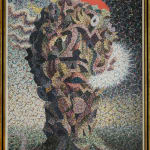-
Artworks
Henry Orlik b. 1947
CYCLOPS: SELF-PORTRAITAcrylic on canvasImage: H. 171 cm. x W. 133 cm; H. 67in. x W. 52in.
Frame: 182.5cm x W. 144.5cm x D. 5cm; H. 72in. x W. 57in. x D. 2in.With artist stamp versoWB2561Copyright The ArtistFurther images
In Cyclops: Self-Portrait, Orlik turns his all-searching eye onto himself. In prescribing the title ‘Cyclops’, Orlik playfully suggests his singular-vision and his single-mindedness. Misunderstood and alienated, Orlik has lived only...In Cyclops: Self-Portrait, Orlik turns his all-searching eye onto himself. In prescribing the title ‘Cyclops’, Orlik playfully suggests his singular-vision and his single-mindedness. Misunderstood and alienated, Orlik has lived only for his art and his vision of the world, which finds extraordinary expression in his paintings.
Despite the title, the painting includes two eyes – Orlik never settles for a singular reading. One eye, most reminiscent of Cyclops, is a round white object with a central black dot, unseeing and superficial; the other is an arched window, an eye to the soul. The black shadow within the cross of the frame suggests the impenetrable core of the mind, drawing the viewer inside.
Orlik’s self-portrait is made up of a plethora of shapes and colours to suggests the many facets and elements that make up the self; its complicated format suggests the impenetrable and convoluted neurons that make up the functions of the brain and the bones, muscles and blood vessels that create the skeleton of the head. Cleverly formed out of blocks of circular drum-shapes, triangles, rectangles and squares which together reveal the head, it has four spirals appearing out of the back of the head to suggest hair or maybe thoughts streaming from the head. Additionally, a red sun rises above the head emitting four rays of gold light. The playful image includes a winding road which leads into the neck through a small tunnel and smoke coming out of the mouth, like the exhalation of a cigarette as the artist insouciantly watches us watching him.
The self-portrait is a rite of passage for artists and has resulted in some of the most powerful works across the ages, as gifted painters grapple with their identity and their perception, both of themselves and the world. For the Surrealists, from Dali to Magritte, it has led to some of the most visually arresting. In Cyclops, Orlik makes his own distinct and vital contribution.
Join our mailing list
Be the first to hear about our upcoming exhibitions, events and news
* denotes required fields
We will process the personal data you have supplied to communicate with you in accordance with our Privacy Policy. You can unsubscribe or change your preferences at any time by clicking the link in our emails.






